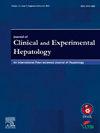Therapeutic Options for the Management of the Cholestatic Phase of Viral Hepatitis A and E—A Systematic Review
IF 3.2
Q2 GASTROENTEROLOGY & HEPATOLOGY
Journal of Clinical and Experimental Hepatology
Pub Date : 2025-03-24
DOI:10.1016/j.jceh.2025.102557
引用次数: 0
Abstract
Background/Aims
The cholestatic hepatitis associated with acute viral hepatitis leads to prolonged jaundice and pruritus. While several treatment approaches have been proposed, there is a noticeable absence of agreement over the most effective course of action. The goal of this systematic review is to compile and assess the available data on treatment approaches for prolonged hepatitis associated with viral hepatitis.
Methods
We comprehensively searched for relevant studies in MEDLINE, Embase, and Scopus from their inception to May 2024. Studies reporting the treatment option for the management of the cholestatic phase associated with viral hepatitis were included.
Results
A total of 28 studies describing 164 patients were included in the review, of which 18 were case reports, 8 were case series, and 2 were interventional studies. The benefit of ursodeoxycholic acid (UDCA) was reported in two case reports, with doses varying from 10 to 30 mg/kg/d in the included studies. The use of corticosteroids in adult patients was reported in 21 studies, with prednisolone doses varying from 30 to 60 mg/day in adults. Two studies used nasobiliary drain (NBD) for patients who failed to respond to conventional therapy. Lastly, three studies reported using plasma exchange (PLEX) in patients refractory to standard treatment.
Conclusion
Patients not responding to UDCA or cholestyramine may benefit from a short course of corticosteroids, suggesting an immune-mediated phenomenon. NBD placement or PLEX may be tried after analyzing the risk-to-benefit ratio for patients who are nonresponsive to corticosteroids. Further research is required to determine the optimal treatment strategy.

病毒性甲型肝炎胆汁淤积期的治疗选择和E-A型肝炎的系统评价
背景/目的与急性病毒性肝炎相关的胆汁淤积性肝炎会导致长时间的黄疸和瘙痒。虽然已经提出了几种治疗方法,但对于最有效的治疗方案却明显缺乏共识。我们在 MEDLINE、Embase 和 Scopus 中全面检索了从开始到 2024 年 5 月的相关研究。结果共纳入了 28 项研究,描述了 164 名患者,其中 18 项为病例报告,8 项为病例系列,2 项为介入研究。有两份病例报告指出熊去氧胆酸(UDCA)的益处,纳入研究的剂量从 10 毫克/千克/天到 30 毫克/千克/天不等。21项研究报告了成人患者使用皮质类固醇的情况,成人患者的泼尼松龙剂量从30到60毫克/天不等。两项研究对常规治疗无效的患者使用了鼻胆管引流术(NBD)。结论对 UDCA 或胆碱酯酶无效的患者可能会从短期皮质类固醇治疗中获益,这表明这是一种免疫介导的现象。对于皮质类固醇治疗无效的患者,在分析了风险与收益比之后,可以尝试植入 NBD 或 PLEX。确定最佳治疗策略还需要进一步研究。
本文章由计算机程序翻译,如有差异,请以英文原文为准。
求助全文
约1分钟内获得全文
求助全文
来源期刊

Journal of Clinical and Experimental Hepatology
GASTROENTEROLOGY & HEPATOLOGY-
CiteScore
4.90
自引率
16.70%
发文量
537
审稿时长
64 days
 求助内容:
求助内容: 应助结果提醒方式:
应助结果提醒方式:


